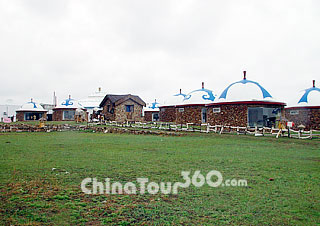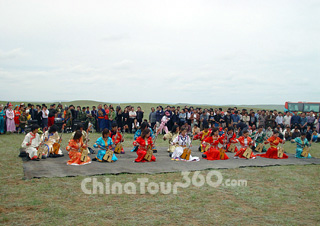 Gegentala Grassland, Inner Mongolia
Gegentala Grassland, Inner Mongolia Performance, Gegentala Grassland
Performance, Gegentala Grassland
Inner Mongolia, China's northern border autonomous region, features a long, narrow strip of land sloping from northeast to southwest. It is the third-largest subdivision of China spanning almost 300 million acres or 12 percent of China's land area. Inner Mongolia stretches 2,400 kilometers (1,491 miles) from west to east and 1,700 kilometers (1,056 miles) from north to south. It traverses between northeast, north, and northwest China and borders Russia and Mongolia in the north with a boundary line as long as 4,221 kilometers (2,623 miles), thus becoming an important frontier for China's opening to the outside world.
It has a population of about 24 million (in 2004). Capital city is Hohhot while the largest city is Baotou. It has not only a large area but also geographical advantages, bordering Heilongjiang, Liaoning, Jilin, Hebei, Shanxi, Shaanxi and Gansu provinces as well as Ningxia Hui Autonomous Region in the east, south and west.
Besides hills, plains, deserts, rivers and lakes, Inner Mongolia has plateau landforms, mostly over 1,000 meters (about 13,780 feet) above sea level, including the Inner Mongolia Plateau, the second largest among the four major plateaus in the country. So, essentially it is an inland plateau with a flat surface and fringed by mountains and valleys.
Inner Mongolia, with a temperate continental monsoon climate, has a cold, long winter with frequent blizzards and a warm, short summer. It has a mean annual temperature of -1 to 15 degrees Centigrade (30.2 to 59 degrees Fahrenheit) - the hottest month, July, averaging 15 to 25 degrees Centigrade (59 to 77 degrees Fahrenheit) and the coldest month, January, -30 to 10 degrees Centigrade (-22 to 50 degrees Fahrenheit). The difference of temperature between day and night is great.
Inner Mongolia has abundant tourist attractions: colorful ethnic culture, grassland scenery, the virgin forests in the Greater Hinggan Mountains, grand views along the Yellow River, the majestic Singing Sand Ravine, rivers, lakes and springs. Inner Mongolia is home to the Mausoleum of Genghis Khan, the Zhaojun Tomb, ancient Great Wall in Inner Mongaolia, Wudang Monastery at the bottom of the Yinshan Mountains, Wuta Monastery, Bailing Temple, and tomb murals dating back to the Eastern Han Dynasty (25 - 220). Especially, its natural beauty is embodied by the vast grasslands, mushroom-like yurts, bright sky, fresh air, rolling grass and the flocks and herds moving like white clouds on the remote grassland. For those who visit Inner Mongolia, the big attraction is the chance to view the grasslands, perhaps ride horses, and see the Mongolian way of life.







